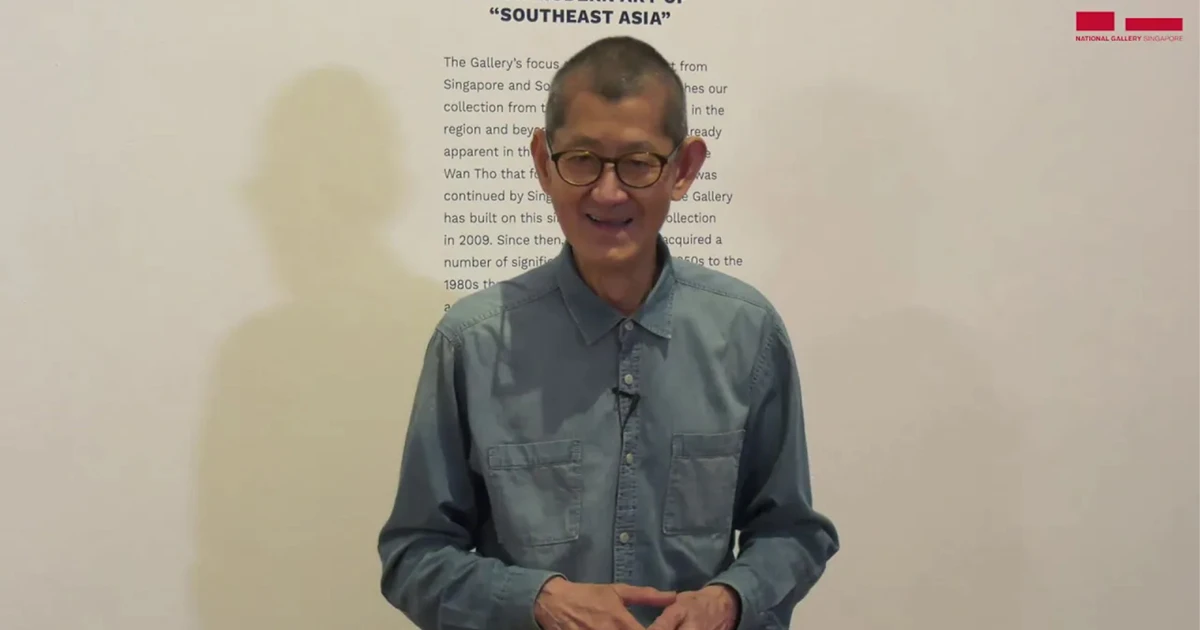The first artwork in our National Collection
Do you know that this self-portrait was the first artwork to be accessioned into our art collection? Find out more about the National Collection and how it started.

Self-Portrait
c. 1950s
Batik, 31 x 21 cm
Gift of Loke Wan Tho Collection
Collection of National Gallery Singapore
Image courtesy of National Heritage Board
Set against an intense red background, Chuah Thean Teng gazes resolutely at the viewer, exuding steely confidence. In contrast to his later, more stylised works, Chuah experiments here with the effects of light and shadow, striving to create a balance between figuration and abstraction through the medium of batik. The artist is known for vibrant, richly coloured works depicting everyday life in Malaya. He pioneered the transformation of batik from a traditional textile medium into a form of fine art, and has influenced many artists.
Self-Portrait is the first artwork to have been accessioned into our art collection. The provenance of this work highlights the key role that private patrons have played in the formation of our collection. It was purchased by Dato Loke Wan Tho from art promotor Frank Sullivan, and subsequently donated to Singapore.
The tall, elegant figure of Dato Loke Wan Tho was a common sight at exhibition openings during the 1950s and 1960s. A leading arts patron, he donated over 110 works to the state in 1960 and subsequent years, with the wish that this collection would eventually be housed in a new art gallery. His own attempt to establish a community art gallery, in 1957, was unsuccessful. Loke worked with many other notable inviduals to build his collection, including Australian art promotor and critic Frank Sullivan, from whom Loke acquired over 60 works in 1957.
***
Singapore's National Collection has over 280,000 objects, of which about 10,000 are artworks. Of these, more than 8,600 artworks are overseen by the Gallery, and form “the Gallery’s collection.” This makes the Gallery’s collection the world’s largest institutional collection of modern and contemporary art ofSingapore and Southeast Asia. The artworks that the Gallery acquires add to the National Collection.
The Gallery’s collection has been uniquely shaped by the changing landscape of art institutions here, and the numerous exhibitions held by various museums over the years. Its beginnings can be traced to the donation of over 110 artworks to Singapore in 1960 and subsequent years by Dato Loke Wan Tho, an art philanthropist and the co-founder of Cathay Organisation. Uniquely shaped by the changing landscape of art institutions here, institutional shifts and numerous exhibitions held by various museums over the years have all left their distinctive marks on the Collection. In 1954, Singapore's Finance Committee designated $10,00 for the acquisition of artworks for the proposed art gallery in the then Raffles Musuem. Despite this effort and Loke's foundational donation, a national art museum remained an unrealised dream as Singapore focused on forging its nationhood. It was only in 1976 that the first state-run art museum, the National Museum Art Gallery (NMAG), opened in what is now National Museum of Singapore. It was succedded by Singapore Art Museum (SAM) in 1996. When national Gallery Sngapore opened in 2015, the National Collection's visual artworks were reallocated between the two institutions, with the Gallery focusing on the 19th and 20th centuries.
"The chief purpose of the gallery... will be to show to the public from time to time the efforts of our best artists—who, I am convinced, rate among the best of the contemporary artists."
—Dato Loke Wan Tho, quoted in "At long last an art gallery for Singapore," The Singapore Free Press, 30 October 1957, 2.
This article was adapted from the publication (Re)collection: The Making of our Art Collection, which was published in conjunction with an exhibition by the Gallery of the same name. Find the publication in the Gallery's Rotunda Library & Archive. You can also explore the Gallery's collection of artworks and archival material on our Collections Search Portal.












